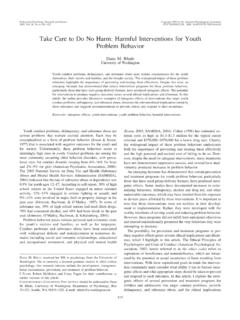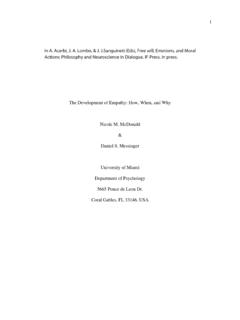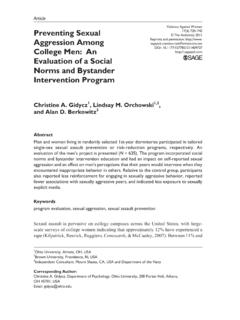Transcription of Running head: POSITIVE ACTIVITIES AT WORK 1
1 Running head: POSITIVE ACTIVITIES AT WORK 1 Recalling POSITIVE Events at Work Makes Employees Feel Happier, Move More, but Interact Less: A 6-Week Randomized Controlled Intervention at a Japanese Workplace Joseph Chancellor Kristin Layous Sonja Lyubomirsky University of California, Riverside Word Count: 5245 in press, Journal of Happiness Studies Please address correspondence to: Joseph Chancellor 900 University Avenue Department of Psychology University of California Riverside, CA POSITIVE ACTIVITIES AT WORK 2 Abstract Simple self-administered ACTIVITIES , such as practicing gratitude or kindness, have been shown to increase happiness, yet only self-report measures have been used so far.
2 Our study, conducted with a Japanese workplace sample, incorporated a novel technology to gather precise behavioral data reflecting participant movement and social interactions. Employees were randomly assigned to either recount three POSITIVE events at work (a POSITIVE activity) or list work tasks they completed (control) weekly for 6 weeks; furthermore, they reported their happiness levels and wore sociometric badges that recorded their behavior. Relative to controls, participants who considered good things at work not only reported relatively greater happiness over time but moved more upon arriving to work, engaged in less social interaction, and left the office earlier.
3 Most of the findings were moderated by participant effort, such that those who put more effort into the POSITIVE activity also showed greater changes. Keywords: happiness, subjective well-being, POSITIVE ACTIVITIES , POSITIVE activity interventions, sociometric data, behavioral data POSITIVE ACTIVITIES AT WORK 3 Recalling POSITIVE Events at Work Makes Employees Feel Happier, Move More, but Interact Less: A 6-Week Randomized Controlled Intervention at a Japanese Workplace Introduction People around the globe acknowledge that the pursuit of happiness, or subjective well-being, is a high-priority life goal (Diener, 2000). Given the many benefits of happiness, this preoccupation is not unwarranted.
4 POSITIVE emotions a core component of well-being are associated with desirable outcomes across a number of life domains, such as work, relationships, and physical health (Lyubomirsky, King, & Diener, 2005). Fortunately, research over the past decade has established that engaging in POSITIVE ACTIVITIES for example, performing acts of kindness (Layous, Nelson, Oberle, Schonert-Reichl, & Lyubomirsky, 2012) or expressing gratitude (Emmons & McCullough, 2003; Lyubomirsky, Dickerhoof, Boehm, & Sheldon, 2011) can sustainably increase happiness in practitioners (see Layous & Lyubomirsky, 2014; Lyubomirsky & Layous, 2013, for reviews). Broadly, POSITIVE ACTIVITIES are simple, intentional, and regular practices meant to mimic the myriad healthy thoughts and behaviors ( , prosocial behavior, grateful and optimistic thinking; Lyubomirsky & Layous, 2013) that happy people naturally engage in.
5 However, the research on POSITIVE ACTIVITIES to date has suffered from several significant limitations. First, experimental interventions to test the efficacy and boundary conditions of POSITIVE ACTIVITIES are predominantly conducted in the West. Second, they neglect the workplace. Third, and perhaps most important, they fail to measure actual human behavior. Our study sought to remedy each of these shortcomings by experimentally testing a POSITIVE activity in a Japanese workplace sample and collecting behavioral data. POSITIVE ACTIVITIES AT WORK 4 Expanding Outcome Variables: Sociometric and Ambulatory Behavioral Measurement A primary aim of our study was to examine whether a specific POSITIVE activity a grateful thinking exercise involving recalling three good things that occurred each week at work can lead to increases in happiness over time.
6 In addition to collecting self-reports of happiness, however, we also examined how the POSITIVE activity might change the employees actual behavior specifically, their physical movements and social interactions over time. A frequent criticism leveled against social and personality psychology is that it overlooks actual behavioral variables (Baumeister, Vohs, & Funder, 2007). Psychologists often instead rely on self-report surveys, which are subject to numerous cognitive and memory biases ( , Kahneman, Krueger, Schkade, Schwarz, & Stone, 2004). That behavioral variables are usually excluded from studies is testament to the difficulties and hassles associated with observing, recording, and coding participants behavior.
7 Fortunately, recent technological developments, such as computer miniaturization, long-lasting batteries, and wireless communication, are facilitating a new approach to behavioral monitoring that is more robust and less laborious than traditional methods. Also, because miniaturized devices can be worn unobtrusively, researchers can monitor participants in naturalistic locations, such as schools or workplaces, rather than confining them to artificial laboratory environments. In this study, we used a custom-built ambulatory assessment device with sociometric instruments (measuring face-to-face interactions), which resembles an employee badge or name tag. Specifically, this sociometric badge, the Hitachi Business Microscope , allowed us to measure levels of physical activity throughout the day, as well as amount of time spent in social interactions.
8 The badge has been used in studies of flow, knowledge transfer, and interoffice communication (for more information about the device and POSITIVE ACTIVITIES AT WORK 5 corresponding research, see Yano, Chancellor, & Lyubomirsky, 2012). For example, researchers have found that participants consistency in ambulatory movement correlates with the likelihood of being in a state of flow or engagement (Ara et al., 2009). Hitachi has used such data to offer feedback to employees to help them balance knowledge sharing ( , interacting with other employees) and knowledge creation ( , time alone concentrating; Sato et al., 2009; Tsuji et al., 2009). This new technology gave us an opportunity to employ ambulatory and sociometric measurements to validate that the practice of a POSITIVE activity would not only produce changes in our participants self-reports, but also in their actual behaviors, as well as to explore the ways such behavioral changes would be manifested.
9 Would individuals who regularly engage in a POSITIVE activity become more or less social, and how would their levels of physical activity shift throughout the course of the study? Expanding the Generalizability of POSITIVE ACTIVITIES : A Japanese Workplace Sample Despite the advances made in cross-cultural correlational well-being research (Diener & Diener, 1995; Uchida, Norasakkunkit, & Kitayama, 2004), randomized controlled POSITIVE activity interventions still primarily rely on samples from North America and Europe (for exceptions, see Layous, Lee, Choi, & Lyubomirsky, 2013; Otake et al., 2006). This over-reliance on Western samples limits the conclusions that can be made, as one s culture may impact one s pursuit of happiness (Diener & Diener, 1995; Diener & Suh, 1999).
10 Foreign-born Asian-Americans, for example, have been found to derive less benefit from expressing optimism and conveying gratitude than Anglo-Americans (Boehm, Sheldon, & Lyubomirsky, 2011), possibly due to cultural differences in the value ascribed to self-improvement and individual goals POSITIVE ACTIVITIES AT WORK 6 (Triandis, 1995). In this study, we aimed to validate the efficacy of a POSITIVE activity intervention in a population residing in a non-Western, collectivist country specifically, Japan. Another limitation of prior research is that, to our knowledge, randomized controlled POSITIVE activity interventions ( , actual experiments) are not often, if ever, conducted in occupational settings, prompting organizational psychologists ( , Fisher, 2010) to recommend that researchers conduct experiments in the workplace using well-being and occupationally-relevant variables as outcomes.



